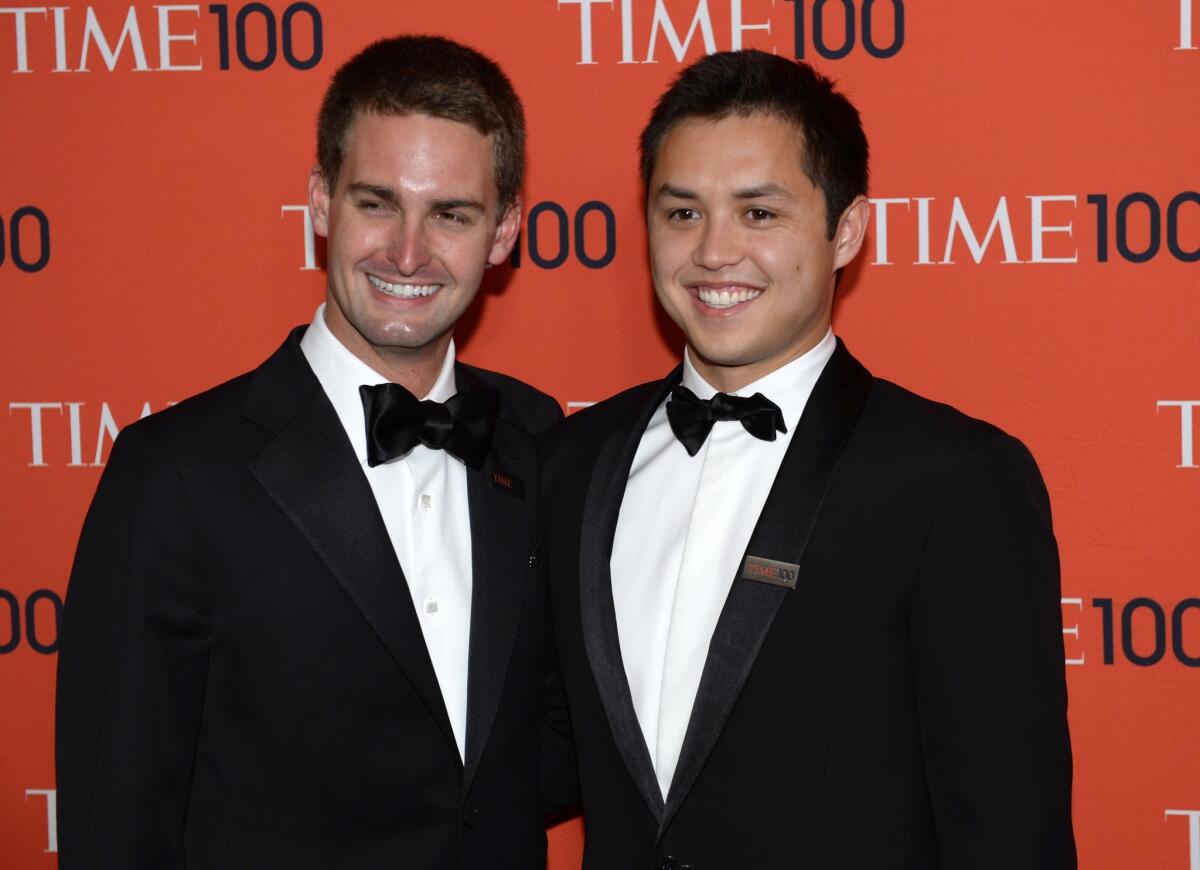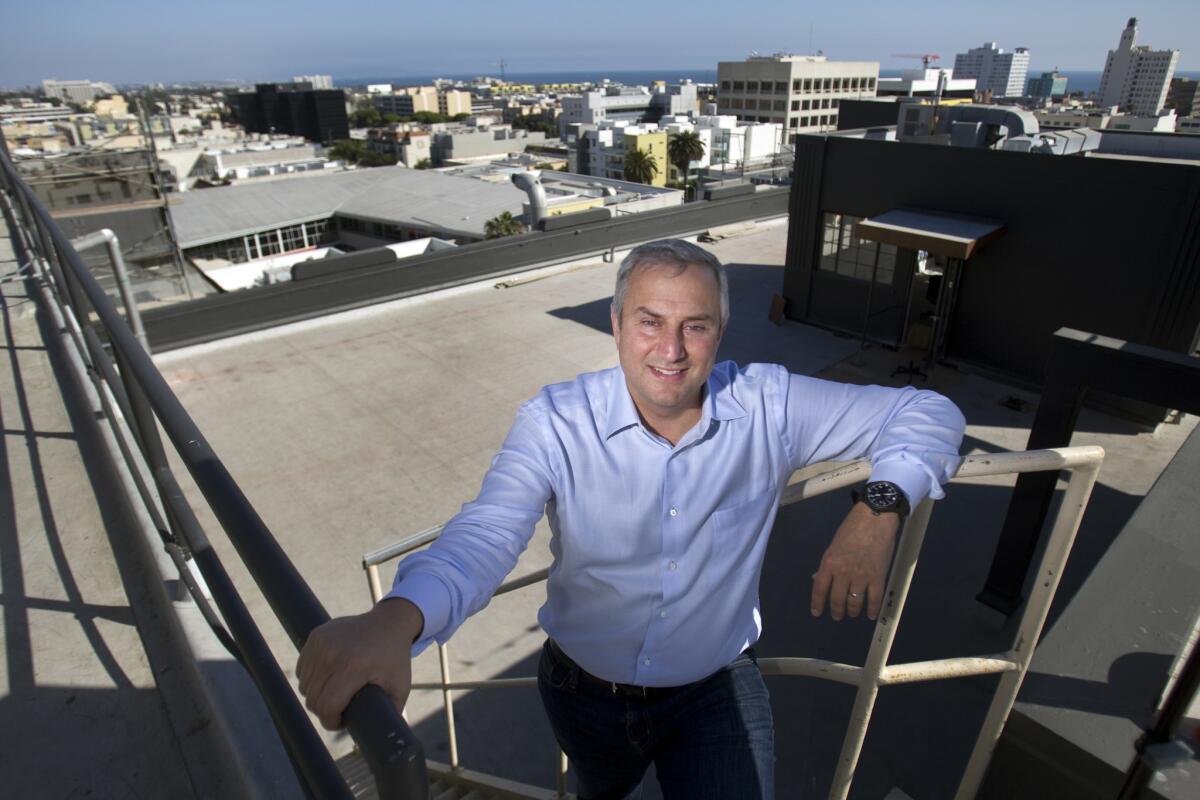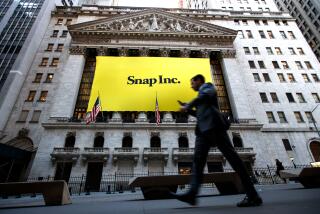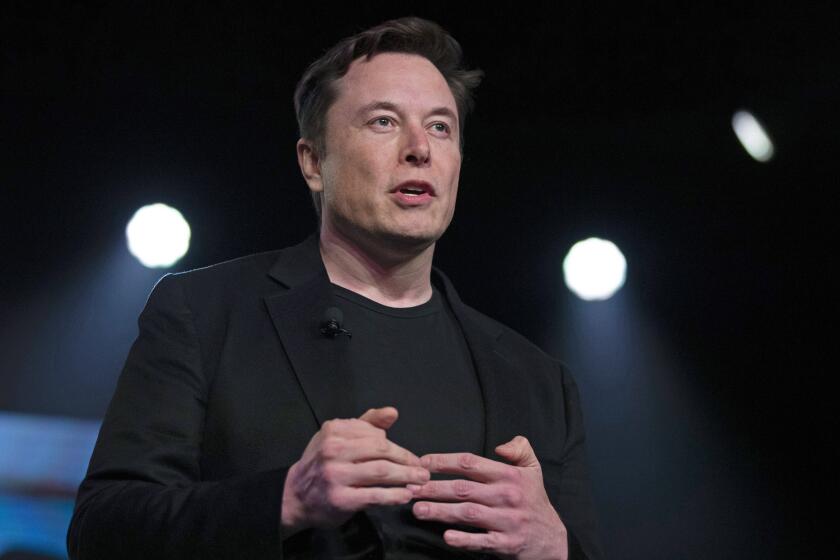Snap Inc. is headed toward Los Angeles’ biggest IPO ever. How come local venture capitalists missed out?

- Share via
Snapchat is on track to hold the biggest initial public offering of stock for a Los Angeles company, yet none of the region’s major start-up investors stand to profit.
Of the nearly $3 billion that Snap Inc. has raised from investors for technology and hiring ahead of next month’s expected IPO, almost none of it has come from Los Angeles financiers.
The county’s leading venture capital firms — the investors that technology entrepreneurs often turn to for money and advice — knew the photo-messaging app had become a hit among teenagers. But for a variety of reasons, they passed on financially supporting the company.
Between Snapchat’s founding at Stanford University in the spring of 2011 and its rise to the global stage in 2013, Los Angeles firms had a short window to get a sizable piece of the company.
At Upfront Ventures, the largest start-up investor based in Los Angeles, associate James Bailey urged managing partner Mark Suster to take a meeting with Snapchat. But Suster dismissed the app as a tool for sexting and marital infidelity.
CrossCut Ventures and Clearstone Venture Partners didn’t have enough free cash to make a bet on Snapchat. For many firms, including Baroda Ventures, CT Ventures and Rustic Canyon Partners, a chat app with no business plan didn’t fit the profile of a company they’d back.
“We did not see the real revenue potential back then,” CT’s Alex Suh said.
The missed opportunity isn’t an indictment of the firms’ ability to spot world-changing start-ups. If anything, it illustrates how much of an anomaly Snapchat maker Snap Inc. is by technology industry standards.
But now as early shareholders become free to sell their holdings, hundreds of millions of dollars in possible investment profits will instead flow through Silicon Valley, bolstering the region’s booming start-up scene.
“You’d have to be an idiot to say I’m not bummed, but we’re very positive on the emergence of Snapchat,” Suster said.
Stanford University fraternity brothers Evan Spiegel and Bobby Murphy began working while students on what would become one of the world’s most used photo-and-video-sharing apps.
Located in Silicon Valley, the school has long been a launchpad for budding technologists. One of Spiegel’s classes introduced him to industry leaders, including Alphabet’s Eric Schmidt. And Murphy worked at a San Francisco start-up during the early days of Snapchat.
In 2013, the pair planted corporate headquarters in Los Angeles, where Spiegel grew up and saw potential for Snapchat to benefit from its cultural diversity and Hollywood connections. But their acquaintances and roots remained in the San Francisco Bay Area, said William Quigley, a managing partner at Clearstone.
The ties included the company’s first funding — a nearly $500,000 check from Silicon Valley shop Lightspeed Venture Partners that valued Snapchat at about $4 million. Lightspeed partner Barry Eggers had heard that the app was taking off in Southern California high schools (Spiegel’s young cousin in Orange County had been among the early promoters).
Eggers’ colleague Jeremy Liew tried repeatedly to get in touch with Spiegel. It was a Facebook message that ultimately drew a quick reply, in part because Liew’s profile picture with President Obama made him seem legitimate. Needing cash to expand on Snapchat’s rapid popularity, Spiegel accepted Lightspeed’s investment.
Heading into the IPO, Lightspeed could generate a 5,000-fold return, or $2.5 billion, based on its initial $500,000 investment. That’s well above Silicon Valley’s 20-fold standard of success.
By the end of 2012, as Snapchat was seeking more cash, Liew and other Bay Area connections already had made the start-up the talk of the town despite its base in Los Angeles.
“They had the luxury of picking who they wanted to work with,” said Peter Lee, managing partner at L.A.’s Baroda Ventures.
Spiegel also held “a relatively dim view of Los Angeles venture capitalists’ ability to understand the opportunity and advise on tactical choices,” said Bailey, now managing partner of Velos Partners. “Right or wrong, he felt they were out of touch on social and mobile platforms.”
Silicon Valley venture capital firms held stronger reputations, longer track records and deeper pockets, now with several $1-billion funds.
“Los Angeles firms couldn’t compete in that realm,” Lee said.
CrossCut Ventures was managing about $5 million, a pittance compared with the $425-million fund of Benchmark, the lead investor in Snap’s early 2013 financing. CrossCut had told potential investors in its fund that a Los Angeles company would make it big someday, not realizing the breakout start-up already was down the street, managing partner Rick Smith said.
In Clearstone’s case, Quigley knew the Snapchat investment would be expensive. He didn’t even try to meet with Spiegel.

At Upfront, Bailey saw his two brothers — one of whom was in Spiegel’s Stanford fraternity — open the app 15 times a day during vacation. Bailey told Suster of the rabid usage and Snapchat’s unique features.
But Suster felt troubled backing a company associated with sexting, since the self-destructing messaging app first gained attention as a way to more securely send nude photos. In the back of his mind was a recent pitch from TigerText, a disappearing text-messaging app he said was named after golfer Tiger Woods, whose philandering had been documented in raunchy texts.
“I thought Snapchat was picture-based TigerText,” Suster said. “I wrote it off and didn’t take it seriously. But I don’t feel too badly about it. It was just a wrong judgment call.”
Since then, Snapchat has evolved well beyond disappearing messages with a full slate of video-editing and entertainment features.
Snap declined to comment for this story.
Other Los Angeles investors passed because their aversion to “a moonshot mentality” encourages safer investments, said David Siemer, managing partner at Santa Monica investment group Wavemaker Partners.
“You will miss a Snapchat, but you will also miss a whole bunch of zeroes,” he said, referring to buzzy start-ups that flame out and don’t produce profits for investors. “It would be very unlikely that we invested in a company that needs $100 million to get to one penny of revenue.”
Silicon Valley funds with more cash to spend and powerful industry relationships can afford a different mentality.
Benchmark, a San Francisco venture firm that previously had bet on Twitter and Yelp, pounced with aggression and led a $12.5-million investment in Snapchat in early 2013 that valued the company at more than $60 million. After the IPO, Benchmark could be the biggest voter in company matters other than executives and directors. Its investment could be returned 300-fold.
The financing also pooled cash from SV Angel, a fund tied to mega San Francisco investor Ron Conway, and General Catalyst. Institutional Venture Partners led an additional $80-million investment later that year.
As Silicon Valley funds poured into Snapchat, Los Angeles firms lost interest, fearing any small investment they would be able to make wouldn’t be worthwhile. They also didn’t want to stray from their core philosophies just for the cachet of being a Snap investor.
Snap, however, kept growing, to a value of more than $16 billion. In hindsight, even late-stage investors stand to make big bucks.
“As a venture capitalist, you want to stick to what you know best and what investors gave you money to do, and no one in L.A. had that mandate,” CrossCut’s Smith said.
L.A.’s venture funds typically have specialized in getting unproven start-ups off the ground. But now, some investors are thinking about forming firms that make larger investments into more established companies, like Snap was by 2013, Lee said. That would require a skill set less prevalent in the Los Angeles community.
Altogether, Snap reports 305 shareholders. No investment groups besides Benchmark and Lightspeed have a stake of more than 5%, a regulatory threshold for disclosing ownership.
Snapchat also took money from, among others, a hedge fund (Coatue), boutique investment firms (Glade Brook Capital and York Capital), mutual funds (Fidelity and T. Rowe Price), corporations (Alibaba and Yahoo) and funds tied to political regimes (Saudi Arabia and Singapore).
Los Angeles isn’t without Snap shareholders, but they’re smaller and behind the scenes. Siemer said L.A. friends bought direct or indirect stakes in Snap totaling around $10 million at multibillion-dollar valuations.
But for all the excitement Snap’s upcoming IPO is bringing to L.A.’s tech community, Los Angeles venture capital firms won’t have anything to brag about.
“We can’t do every deal,” Suster said. “The question is can we do a preponderance of them? And are we active enough that we are helping more companies bet on L.A. and get started and financed in L.A.? The answer is a resounding yes.”
Twitter: @peard33
UPDATES:
12:10 p.m.: This article was updated with additional information about some of the venture funds.
This article was originally published at 3 a.m.







